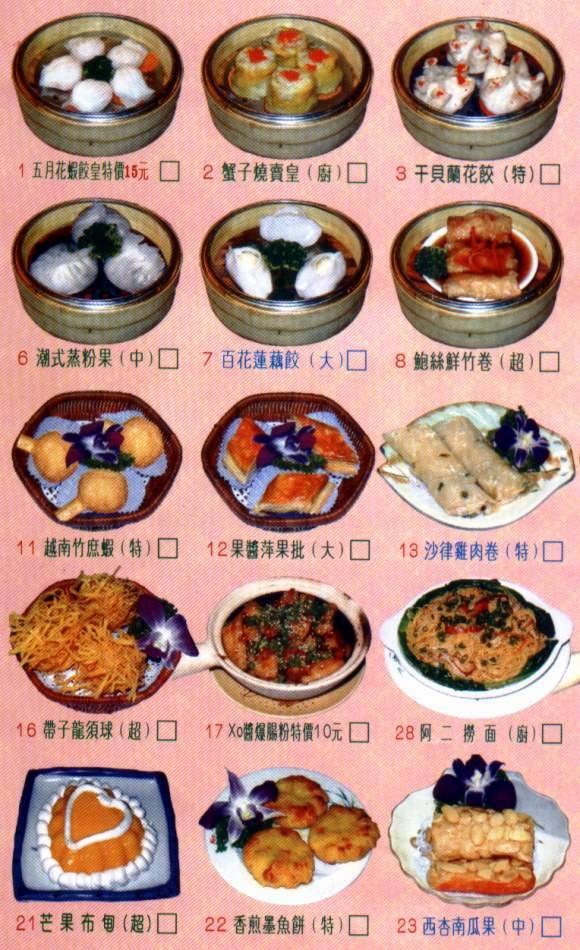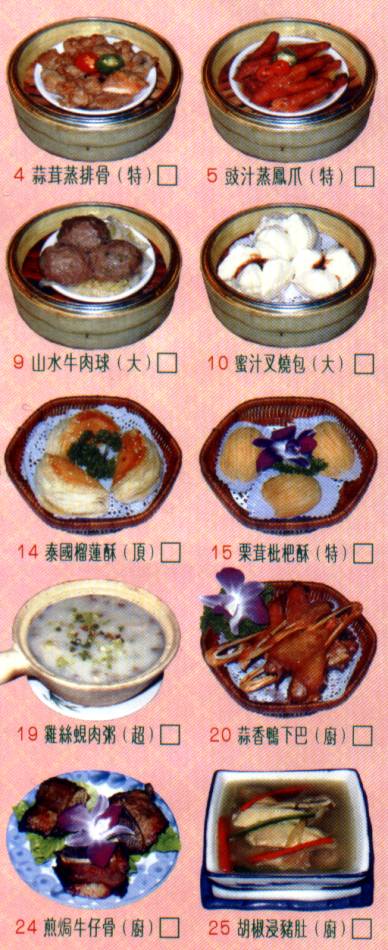Chinese Dim Sum
These are Steamed foods from Shenzhen China


#2 Xiao Mai (Pork And Prawn) #4 garlic chopped(pork) #5 sweet sauce chicken feet #9 Beef ball This was from a resturant menu in Shenzhen China The May Flower Resturant. And it was very very good.
#10 cha shao bao (bread and pork inside) #14 Durian fruit crisp #15 Dian Xin (millet and loquat crisp)
#19 Xi Fan (Clam) #20 garlic duck chin #24 fried Beef bone #25 pepper dip pig tummy
If you can read the Chinese Charactors and have time please tell me what these are in english and I will try to put it on the website.
Wow I am hungry for these again. My favorite is the xiao mai. #2.
Chinese Food Overview
|
We found this on line to give you some insite on Chinese Foods. In the west, people are used to takeout Chinese food such as fried rice, or chicken balls or sweet and sour whatever, etc. This is a small sample of Chinese food and usually quite westernized. Try the authentic food There is an enormous variety of Chinese food that differs greatly from region to region. One interesting thing about traveling in China or Hong Kong is to try out different food. You will find how different from what you have known from the fast food stand and how enjoyable it will be if you just release yourself from traditional food paradigm. Food is a central part of the Chinese culture Chinese cuisine is one of the greatest methods of cooking. Many elements that have influenced its development. The Chinese people enjoy eating good food at all levels of society so cooking has developed into a very sophisticated art. Confucius once said: "Eating is the utmost important part of life." A delightful and delicious meal creates happiness, harmony, mental and physical well-being. Prosperity is another element that has influenced Chinese cooking. During China's long history, she had several "golden eras". When peace, good weather and intelligent leaders were combined, both the people and the monarchs developed their culture through art, science, and countless good recipes. Today Chinese, after one hundred years of suffering, are again enjoying their stability and good life. You can try out all the good Chinese food all over the world. Famine and hardship Famine and hardship played a large role in the development of the cuisine. China has been an agricultural civilization for thousands of years and has suffered from poor harvests. During lean years, people would explore everything eatable to stay alive. Many strange and incredible ingredients such as wood ears, lily buds, etc. were discovered and added to Chinese recipes. The scarcity of food also taught people how to avoid waste. Various fruit and vegetable peels and even shark fins turned out to be delicacies in Chinese food. Energy Saving The lack of cooking fuel from thousands of years of settlement and clear-cutting prompted the development of stir-frying. The need to save fuel became so influential that most Chinese dishes require a lengthy preparation but only a few minutes cooking time. With the current energy crisis the Chinese cooking method offers a practical way to conserve fuel while it delights the taste buds. Healthier and Tasteful Most Chinese dishes are cooked with meat and vegetables together, so the foods contain lower calories and are less rich than Western style food. Vegetables stay bright and crisp by cooking them for a short time over high heat, either in their own juice or in a small amount of water. This method retains most of the vitamins and minerals. Cuisines in Shenzhen In Shenzhen, wherever you go, you will always find places happy to cater to whatever craving or curiosity that hits you at any moment. From streets, restaurants, noodle-venders, and pushcarts, to hotel restaurants, Shenzhen offers a variety of delicious foods you could ever imagine. Cantonese Food
Beijing Food Beijing food is the most famous food of China, particularly known for Beijing Duck. Much of this fame comes from the fact that the Imperial cuisines were based out of there. Beijing Duck is a time consuming dish to prepare of oven roasted duck with a crispy brown skin. Thin slices of the skin are cut off and put onto a plate where it is wrapped with a fresh flour tortilla with plum sauce, cucumber, and green onion. The rest of the duck is used with additional dishes. The northern part of China has a cold climate unsuitable to grow rice, so wheat is the primary grain consumed. Northern Chinese eat more breads than those in the south, where rice predominates.
Huai Yang Food Representing Huai Yang cuisine, Shanghai dishes feature natural flavors. Dishes are light, and sweet. Huai Yang cuisine began during the Pre-Qin Period and was recognized as a distinct regional style during the Ming and Qing dynasties. Raw materials are fresh aquatic products. Famous dishes are stewed crab with clear soup, long boiled dry shredded meat, duck triplet, crystal meat, squirrel with mandarin fish, and Liangxi crispy eel, etc.
Chinese Vegetarian Food
Some noodle knowledge
Soup Chinese soups have been part of Chinese meals for a long time. There are many different types of Chinese soups. Sweet corn and hot/sour soups are the most popular soups to westerners. Chinese make their soups with chicken, meat or vegetable stock. Chinese soups are very tasteful and can be light in both texture and flavor. Yet some of the soups are filling enough to be a meal by themselves. The Cantonese soup is one of the best soup in China and refers to the soup that is cooked for a long time and tasty. It is usually cooked with the clay pot. The method is to put the raw materials in when the water is boiling, then put the fire down and cook it with slow fire for 2-4 hours. There are hundreds of recipes of the soup. The turtle soup, pigeon soup, shark's fin soup, the abalone soup and some others are popular ones. The usual ones are the vegetables and bones. Other ingredients include ginger, dates and other herbal medicine. Chinese Tea
In recent years, foreign chefs, the increasing floods of foreign travelers and diplomats have driven up the number of western, Korean, Thai, and Japanese restaurants. Shenzhen offers a wider variety of cuisine. Thus travelers have more choices.
|
Send Email To:
mailto:mail@artfiberglass.com
Back
Exotic Treks
Artfiberglass Asian Imports